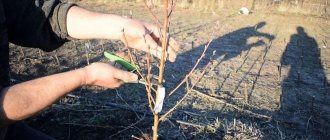Why is pruning needed?
There are a number of reasons for pruning Chinese roses:
- The ability to get rid of irregularly shaped branches:
- too long;
twisted;
- deformed.
Rejuvenation. Lack of proper care for hibiscus will result in the flower spending all its energy on old shoots. Flowering will become sparse, and the crown will not gain lushness.- Sanitary pruning allows you to get rid of shoots affected by disease or pests and prevent the disease from spreading to healthy branches.
- Root pruning is justified only if they grow strongly. This type of pruning also accelerates the growth of hibiscus and promotes abundant flowering.
Over time, new branches will grow in their place.
Do I need to prune indoor hibiscus?
No one doubts that it is necessary to remove dry, broken branches. But is it necessary to shape a Chinese rose, or will the plant do just fine without it?
To answer the question, you need to understand how hibiscus develops:
- the crop begins to bloom at an early age, sometimes buds appear on not fully rooted cuttings;
- the young bush gives good growth;
- corollas are formed only on the shoots of the current year; the longer they are, the more buds there are.
An adult bush, if the branches are not pruned, will not grow quickly. The shoots increase in length by several centimeters every year; many buds simply cannot fit there. And if we take into account that each corolla, even with ideal care of Chinese hibiscus, lasts 1-3 days, flowering will be sparse.
The goals pursued by pinching, pruning and shaping the bush:
- stimulation of growth of young shoots;
- as a result - an increase in the number of buds;
- removal of weak, twisted branches;
- ensuring access of light and air inside the crown;
- height limitation;
- bush rejuvenation;
- maintaining a balance between the size of the root and the aerial part.
When to do the procedure?
When is it better to carry out the procedure: in February, before spring, or in the fall? The main pruning of Chinese roses is carried out in February. Insignificant - in September, after flowering. If you ignore autumn pruning, old side shoots will grow back. But there will be no flowering (why might hibiscus not bloom?). After all, buds appear exclusively on young shoots.
Important: the more often this procedure is performed, the more magnificent the crown will be and the more abundant the flowering.
In summer you should refrain from pruning. There will be no flowering after summer pruning.
Hibiscus hedge
Hibiscus is becoming increasingly popular in the garden as a hedge. This requires special pruning in the autumn months, resulting in a compact hedge shape, and in summer numerous flowers grow on fresh shoots. Pruning should be done in September or October as follows:
- Full cut to one third
- Complete pruning every year
- Trim dried branches, especially in the inner area
Trim your hibiscus hedge so that it is slightly tapered at the top to improve lighting. And in turn reduces the likelihood of premature aging of the internal region of the plant.
Pruning a home flower
How can you prune a house flower? Depending on the age of the plant, its condition and the expected shape of the crown, there are 5 types of pruning:
- Topping suitable for young plants.
- This is the most gentle type of pruning.
- Used to stimulate growth.
- It consists of removing the tops of all branches above the top node.
You need to pinch when the plant is about 13 - 15 cm high.- To strengthen the trunk when pinching, the central shoot is attached to a base (for example, to a bamboo skewer).
- Selective cropping carried out not only to stimulate growth, but also to maintain the shape of the plant. This type of pruning is a more thorough shortening of branches: several already well-developed internodes are cut off. Certain areas that disrupt the shape of the crown are trimmed.
The sequence of this type of hibiscus pruning is as follows:- Trim the side shoots, leaving up to 4 - 5 leaves.
Make the cut just above the node, leaving at least 2/3 of the branch.
- Branches growing parallel to the central trunk and inside the crown also need to be pruned.
- Pruning should be done above the growing point, which faces outward.
Reference: the cut is made at an angle of 45 degrees. - Full pruning ensures abundant flowering of the plant. Produced in early spring to obtain abundant flowering. When fully pruned, each branch is shortened to two to three buds.
- Sanitary pruning involves removing disease-damaged areas of the plant. The cut is made until living wood appears. If the cut is green, then the branch is alive. A brown and white branch cut requires immediate pruning.
When pruning, do not try to leave as many shoots as possible. Don't be afraid to trim! Even if you cut off the excess, the plant will survive everything. Pruning tools must be sharp and disinfected.
Disinfection of cutting tools
Using a dirty cutting tool can quickly lead to the plant becoming infected with various infections, especially on damp autumn days. The transmission of pathogens such as fungi during the autumn months and with dirty cutting tools is more likely, thereby causing harm to garden hibiscus when pruning. Instruments must be disinfected before each use. There are various disinfection options:
Disinfection by fire
The cutting blades of the tool are held over the fire for a few seconds. In this case, it is necessary to ensure that intense contact is created between the blades and the flame for several seconds. This will be enough to destroy bacteria, viruses and fungal spores. The source of the flame can be a gas burner, a lighter or burning alcohol.
Disinfection with alcohol
To effectively disinfect cutting tools, use regular alcohol or isopropyl alcohol. If you use alcohol, then it must be mixed with distilled water in a ratio of 7:1. Isopropyl alcohol should be 70%, you can buy it at the pharmacy. When using alcohol, cutting tools should be placed in the solution and remain completely immersed in it for a minimum of two minutes. After this, wipe the instruments with a clean cloth, or better yet, wait a while for the instrument to dry completely.
Chemical disinfection
You don't have to worry about fungi or bacteria infesting your hibiscus if you treat the blades of your cutting tool with chemicals before pruning.
An example of such a product is “Dimanin”, it is used as a disinfectant against various pathogenic and other microorganisms. You can take a five percent solution and immerse the cutting tool in it for just one minute, all harmful microorganisms will be reliably killed.
How to form a crown at home?
Formative pruning is the most difficult type of hibiscus pruning.
Purpose of the procedure and the best time for it
The Chinese rose is formed in order to obtain the desired shape of the crown and the entire plant. The more often the crown can be shaped by pruning, the better the plant will develop and achieve the correct shape.
They begin to form a crown in the spring, after the plant’s dormant period ends. The shape of the hibiscus is maintained through selective pruning.
How to trim a bush correctly in spring?
The rules for pruning hibiscus depend on what type of crown is expected to be obtained after the procedure. It can be a lush tree, a branched shrub, or a miniature bush.
- To form a Chinese rose in the form of a tree, you should:
- Remove side branches.
- Leave a couple of medium branches, shortening them by only 2 - 3 buds. In the future this will be the main trunk.
- To form a hibiscus in the form of a lush bush you need:
- Trim the middle-most upper branches. At the same time, the lateral buds will begin to form new shoots.
- Shorten the central branch, leaving only a few growing points.
- To form a lush crown:
- Remove all useless branches: internal, parallel to the main trunk, gnarled, deformed and growing inward.
- Clear the crown of faded flowers in a timely manner. This promotes the development and blooming of new buds.
Possible errors and their prevention
It is worth paying attention to what mistakes you should not make when pruning the Chinese Rose:
- You should not perform this procedure during flowering, as this can greatly weaken the plant. If you urgently need to remove a diseased branch, then you will have to do it very carefully, without touching others, and be sure to treat the cut area afterwards.
- You cannot prune a flower in winter, when it is at rest, unnecessary processes may start.
- It is strictly forbidden to take poorly sharpened tools and make cuts with them - after all, you will end up with uneven, torn edges, which will not heal well, and the plant will immediately look sloppy.
Sources
- https://olgaflowers.net/komnatnye/kogda-luchshe-obrezat-gibiskus-komnatnyy.html
- https://selo.guru/rastenievodstvo/derorativ/gibiskus/uhod-gib/obrezka.html
- https://Vikings-WarOfClans.ru/cvety-doma/obrezka-gibiskusa.html
- https://ss-p.ru/remont/kak-pravilno-obrezat-gibiskus.html
- https://kaktys.club/sovety-novichkam/obrezka/gibiskusa
- https://loveflora.ru/molodoy-gibiskus-kogda-obrezat/
- https://vdohnovenie-flowers.ru/kak-obrezat-gibiskus-domashnij-tsvetok-i-kogda/
- https://rusfermer.net/dom-kvartira/tsvety-kv/tsvetushhie/gibiskus/kak-uhazhivat-za-g/obrezka-i-formirovanie.html
- https://helpsad.ru/obrezka-gibiskusa/
- https://jubkiplus.ru/gibiskus-obrezka-formirovanie-kusta-cvetenie.html
- https://vashcvetok.ru/vyrashhivanie/obrezka-gibiskusa
- https://valerie-flowers.ru/komnatnye-rasteniya/kak-pravilno-obrezat-gibiskus-komnatnyj.html
- https://rastenia.info/tsvetyi/gibiskus/obrezka.html
- https://floriums.ru/obrezka-gibiskusa-komnatnogo-i-sadovogo-formirovanie-krony
- https://ydoo.info/qa/kak-obrezat-gibiskus.html
- https://dacha.expert/domashnie-rasteniya/tsvetushhie/gibiskus/vidy-gi/kitajskaya-roza/kak-pravilno-obrezat.html
- https://dacha.expert/domashnie-rasteniya/tsvetushhie/gibiskus/vidy-gi/sadovyj/osnovy-obrezki.html
Caring for Chinese roses immediately after crown formation
The first time after pruning, the Chinese rose needs adaptation:
- Place the plant in a cool corner.
- Cover from direct sunlight.
- Limit watering.
Further care for a trimmed houseplant is no different from usual:
- Watering with warm, settled water as the top layer of soil dries.
- Air humidity is about 50%.
- Spraying and rinsing in the shower. Wiping the leaves with a damp cloth will also work. For the full development of the Chinese rose, the leaves of the flower must be constantly free of dust.
- Feed once a month with complex fertilizers.
- Ventilate the room, but avoid drafts. In summer, it is preferable to take the hibiscus out into the fresh air.
- The lighting should be bright but diffuse.
Choosing an effective propagation method
The choice of propagation method depends on the type of hibiscus and the time of year.
Optimal time
A plant should be propagated when it:
- Absolutely great.
- The branch is bent towards the soil, which creates the possibility of division by layering.
- It has grown so much that you can cut off one cutting.
Hibiscus is propagated in spring and summer; if the flower is damaged by pests or is sick, then division should be postponed until the plant recovers.
Hibiscus is propagated using the following methods:
Cuttings
Can be used all year round, but best in spring and summer. Before pruning, the mother plant should be watered and pruned thoroughly. Along with the withered and limp shoots, cut off the cuttings (branches with a thick green stem and the presence of two internodes). Pick off all the leaves from this shoot and root the flower.
Layerings
No more difficult than the first method. To divide the bush, choose regular, air or vertical layering, the first is best. Sprinkle the selected branch with soil and leave the top open. In a place sprinkled with soil, roots will soon begin to grow. Before propagation, you need to prepare the soil: it must be well moistened, have high air permeability, and drainage is required. The branch that needs to be bent, cleared of leaves and placed in a dug hole in a flowerpot, if necessary, secured with wire so that it does not bend back. This method is applicable in the spring. Already in the fall, you can separate the shoot from the mother plant into a separate pot.
Seeds
The most uncommon and complex method. Moreover, all varietal characteristics of hibiscus are lost. The procedure is as follows:
- soak the seeds in water with growth stimulants;
- put them in a wet gauze cloth and then in a plastic bag for three days, until roots take root;
- plant in a pot with soil and humus;
- Do not deepen the seeds too much and cover the pot with a bag for thermal effect, after 2 weeks remove everything;
- Water moderately and after 3 months transplant the young hibiscus into a larger container.
Dividing the bush
Used in spring and summer. Secateurs, a knife and a spatula must be treated with a disinfectant and the bush must be dug up. Next, clean the root system from the soil, being careful not to damage it. Using a treated knife, cut off 2-3 stems with roots. Afterwards, plant each separated shoot in its own pot, where soil with humus is poured. New flowers should be watered often, but in moderation.
How to root
There are only two ways to root a Chinese rose.
In soil:
- Before planting in the ground, you need to wait until the cuttings give their own roots, lower them into a small glass with soil and sand, before dipping each shoot in a heteroauxin solution.
- After planting, lightly compact the soil at the base; the cuttings take root after a month.
- Build a small greenhouse around the plant in the form of a bag or a piece of glass to keep it warm and humid inside.
In water:
- Use a dark glass glass and pour warm water into it.
- Add a few tablets of activated carbon and a growth stimulator.
- Place the glass in a well-lit place, but out of direct rays.
- Plant in a pot only after the plant produces two or three leaves and the roots reach 5-7 centimeters in length.
Possible problems and difficulties after division
New shoots need to be watered daily, monitored for high humidity and moderate temperatures. If a young red rose is not provided with proper care, it will quickly shed its leaves and begin to wither. To avoid the appearance of mites and aphids, it is advisable to wash the plant with soapy water and wipe with a wet cloth in the shower. If the leaves turn yellow, you need to reconsider the applied mineral fertilizers - add nitrogen and iron and reduce chlorine and calcium.
What to do if the plant begins to wither?
Wilting of hibiscus after pruning is quite rare. The flower is absolutely calm about pruning. And if this happens, the reason lies in a violation of the adaptation regime of the pruned hibiscus or the rules of general care. Let us note the main ones:
- Insufficient watering. Beginning gardeners understand by limiting watering during the adaptation period to almost completely stop it. The frequency and abundance of watering depend on the temperature and humidity of the room.
- An excessive increase in room temperature should be a reason to increase watering.
- A significant decrease in humidity requires additional spraying.
- Use very hot or cold water for irrigation. It should be noted that water should not be left standing under the scorching rays of the sun.
When caring for hibiscus, it is important to replant the plant correctly and on time, which you can learn about in our separate article.
So, the problem of the plant withering after pruning is solved by normalizing the conditions for caring for it . Thus, with proper care, the Chinese rose needs systematic pruning. And the more old and deformed branches are cut off, the more nutrition the young shoots will receive. Only competent formation of the hibiscus crown will make this flower unique in its beauty.
If you find an error, please select a piece of text and press Ctrl+Enter.
Landing rules
- The plant prefers a semi-shaded or bright place.
- Peat, tree bark, preferably hardwood, and perlite are added to the soil; as a percentage, this can be written as 50:45:5.
- A seat for the flower is being prepared, a little larger than it was in the previous flowerpot.
- The hole is watered and time is waited for the liquid to be completely absorbed by the soil.
- The procedure can last up to 60 minutes. If the soil is saturated to a depth of 30 cm during this period, then the soil is selected correctly.
- Seedlings are planted in open ground. In regions with cold climates, the seedling should be buried to greater depths. In warm regions, leave the upper part of the root on the surface of the ground.
- As soon as the seedlings take root, they should be fed with fertilizers.











